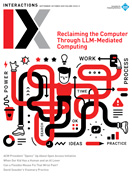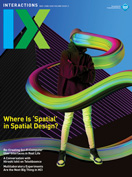Authors:
Elizabeth F. Churchill, Mikael Wiberg
Welcome to the July–August issue of Interactions! In this edition, we cover a lot of ground, bringing together a broad selection of articles.
In our cover story, "Rethinking Human-Centered Design: From Automation to Sustainable Innovation," Michele Visciòla invites us to reconsider human-centered design, suggesting that its role has been increasingly co-opted by industry models that prioritize narrow definitions of "engagement" with shallow metrics. We have been concerned with transactional and short-term business-driven models. Little to no consideration has been given to explorations and models of human agency and human-centered and value-driven ideas of effectiveness. Visciòla argues that the mission of HCD should be deeper; we should go beyond superficial interaction design and shift our thinking to foster cognitive agency, ethical engagement, and long-term sustainability. He offers a compelling case for pushing HCD toward "a more holistic vision that aligns technological innovation with environmental limits, social well-being, and economic sustainability."
In "Stop Hiding My Controls: Hidden Interface Controls Are Affecting Usability," Philip Kortum focuses on the problems that arise when controls are increasingly hidden. Interface complexity has increased, he writes, and in the process, more and more controls are being concealed from the user. This apparent simplicity in the immediate top-level perception of the interface is deceptive; hidden controls, Kortum says, "actually make the interfaces much harder to use for novice users." This is, of course, a tricky line to walk. Read Kortum's article and decide what kind of interface you'd prefer for the apps that you use every day.
AI "red teaming" is a fascinating area of growth where experts simulate real-world attacks on AI systems to uncover vulnerabilities and potential risks. Red hat hackers combat cybercrime by using methods that are aimed at neutralizing malicious actors but may be considered unethical. In this issue's Tech Labor forum, "Effective Automation to Support the Human Infrastructure in AI Red Teaming," Alice Qian Zhang, Jina Suh, Mary L. Gray, and Hong Shen argue that since work such as content moderation significantly relies on human expertise, well-designed automation needs to focus on human proficiency rather than prioritizing unfounded notions of efficiency. Overreliance on automation, they say, will negatively affect red teamers' agency and lead to poorer outcomes, while thoughtful scaling of automation with human oversight is the only way forward for truly adaptive, context-aware risk mitigation.
Reflecting on a column that appeared in Interactions last year, Jeff Johnson and Douglas Schuler present their view on a favorite area for us: participatory design. A central topic of their commentary, "Origins (and Future) of the Participatory Design Conference," is, as the title suggests, the 1990 conference most frequently associated with the inception of the field. Participatory design was originally developed to address issues of power, human rights, and dignity within the field of computing—topics that, Johnson and Schuler argue, remain important. With the widespread uptake and use of interactive technologies and increasing dependence on technological infrastructures, these issues may be even more important today. This is a fascinating commentary on the history of the field, and it invites us to reflect on where participatory design is and where it might go.
In Exit, Renato Verdugo and Scott Minneman ask what makes a photograph unmistakably Vogue and share a stunning image from a collaboration between Vogue Ukraine and Google, which tested AI's ability to detect patterns and generate new editorials in the magazine's distinctive style. Take a look at the image and learn more about this fascinating project in "Strike a Pose: Decoding Vogue Ukraine."
There is much more in this issue, from the design of artificial wombs for premature babies to a reflection on the value of e-waste data collection. Please take a moment to dive in. And, as always, we invite everyone to submit articles to Interactions.
Elizabeth F. Churchill and Mikael Wiberg
[email protected]
Copyright 2025 held by owners/authors
The Digital Library is published by the Association for Computing Machinery. Copyright © 2025 ACM, Inc.







Post Comment
No Comments Found